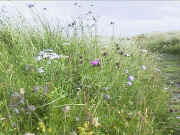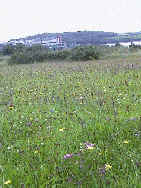|
Native Origin Irish Wildflower Seed Mixtures: Ecotype
Range
Product Code: EC06
Product Name: Seaside Wildflora.
In exposed coastal situations this mixture may not require
cutting. Ideal for light sandy or loam soils, in dry or wet situations.
The Seaside mix will grow short in windy exposed sites or where rabbits
occur, or it can be maintained as a low growing meadow.
EC06 is a
colourful mixture containing a few species that will not grow inland.
This mixture attracts butterflies and Insects.
If used to feed migrant
birds, cease cutting and allow the mixture to set seed in late summer.

Species List: Seaside Wildflora (Mix) EC06
Birdsfoot trefoil
Black Medick
Wild Chamomile
Corn Marigold
Corn Pansy
Corn Poppy
Corncockle*
Cornflower*
Cowslip
Devils Bit Scabious
Meadow Buttercup
Field Scabious
Foxglove
Hemp Agrimony*
Kidney Vetch
Lady's Bedstraw
Lesser Knapweed
Marjoram
Scentless Mayweed
Meadowsweet
Mullein
Ox-eye Daisy
Ribwort Plantain
Sea Mayweed
Selfheal
Sorrel
Thrift
Wild Angelica
Wild Carrot
Yellow Rattle*
Yarrow
Sea Campion
Hare's Foot Clover*
Sea Aster*
If requested
Century is also
available to add to this mixture
*Denotes
a species that is either of diminished national geno-type or specific to
only a few sites, or who's habitat is increasingly threatened,
or the
species is uncommon, rare, becoming rare, is endangered, reintroduced or
saved from extinction.
In all cases, your purchase contributes to DBN's work of creating crops
of Conservation Grade - Native Origin Wildflora.
You help us to inform
and pay land-owners to manage native species and to assist DBN in
handing on our heritage for another generation.
By growing (some will be difficult) these and all other species, you
directly help to conserve national and global Biodiversity and protect
wildlife.
You should also consider yourself another Irish wildflower
grower.
Product
Warning: While
this Ecotype mixture contains the seed of edible and herbal species,
DBN
recommend that this mixture is not for human or animal consumption as it
contains species such as Corncockle and Tree Lupin which are toxic if
ingested.

This
photograph is one day in the life of an ever changing meadow.
Seed
Mixture Specifications:
Total number of seeds per gram:
Native Irish Origin, Wildflower Seed Mixture. EC06All, except waterlogged clay or gley
Moisture Level: Dry, Normal, Moist.
pH range: Best between 5.5 - 6.5 (<7.5)
Aspect: Sunny
Morphology:
Life Cycle: Annual / Biennial /
Perennial.
Height Range: <30cm to >120cm
Flowering Period: June to August.
Fertility Range: Will
grow in very fertile soil to poor, if very
infertile apply fertiliser (see below).
Wintergreen: Yes
The main species which should dominate and persist in this
mixture: Wild Chamomile, Cowslip, Devil's Bit
Scabious, Meadow Buttercup, Field Scabious, Hemp Agrimony, Kidney Vetch,
Lady's Bedstraw, Lesser Knapweed, Marjoram, Scentless Mayweed,
Meadowsweet, Ribwort Plantain, Selfheal, Yarrow Yellow
Rattle.
Annual
Species: Red Bartsia, Yellow Rattle,
Corn Chamomile, Corn Marigold, Corn Pansy, Corn Poppy, Corncockle, Cornflower,
Scentless Mayweed,
Biennial Species: Foxglove,
Mullein, Wild Angelica, Wild Carrot.
Rare, unusual, and feature species: Hare's
Foot Clover, Sea Aster.
Species which will grow if the conditions are ideal: Thrift, Sea
Mayweed,
Species which will be affected by management: Sea Campion. Ox-eye Daisy.
Additional species which could be added to this mixture as individual species of seeds or plants:
Sea Plantain, Sedum Spp.
There are many seaside species that may be
added.
Design
Notes:
Use EC06 on any but
waterlogged soils near the coast. This mix can also be sown on golf
links.
EC06 works well as a low growing meadow, most of the species can be
regularly 'short cut' or mown.
In
exposed coastal situations this mixture may not require cutting as the
foliage will be desiccated by the winter wind.
Sowing Specification:
Do not let the soil dry out, so in early
spring or early September.
Roll or rake into surface to
keep out of reach from birds.
It may be beneficial to protest first
flush seedlings in very exposed situations.
Soil Preparation:
Normal, create fine tilt on seed bed, if clay, ensure a fine tilt or press the seed into clean soil.
Optimum Sowing Time: Spring, early
autumn, when the soil is warm.
Sowing Conditions:
Normal, may suffer drought until well established
Sowing Method: By hand is recommended, if
using seed spreaders be careful to insure the small varieties of seed do
not drop to the bottom of the seed spreader and get sown all in the one
place. Can be Hydrasown.
Fertiliser: None, unless very poor
fertility such as sea sand.
Powdered or liquid seaweed will aid germination.
Seed Sowing Rates:
1.5 to 2 grams per metre.
Normal
sowing rate 'without added grass seed': 1.5 to 2 grams per metre.
High sowing rate 'without added grass seed': Add 4 grams per metre.
Low sowing rate: None
Grass
seed or nurse crop requirement:
Nurse
Crop: A nurse crop is required in exposed coastal situations.
Grass Seed Requirement: Common Bent
Sow with or without grasses: Either
Sowing rate with grasses: 2 to 4 grams per metre.
50% Flora / 50% grass seed, or up to 80% grass where erosion may occur.
If
sown without grasses: This mixture will not require a nurse crop.
Seed Specification:
In normal conditions this mix should germinate 6 weeks
after a spring sowing,
from then on provided the sward is kept open and a 'Thatch' is not allowed develop, species will continue to germinate and emerge,
through
to the third year. If Autumn sown this mixture should be sown late
August or Early September.
Up to 80% of all seed should germinate in the first year.
Up to 70% of all species should germinate in 12 months.
Up to 95% of all species
should have flowered by the fourth year after sowing.
Performance: The
first year is the critical year to maintain this meadow as strong wind
may desiccate the seed bed.

If
this mixture is sow with annuals, or contains annuals, they will flower profusely
in the first year, provided they are sown before June.
They require one
cut when finished flowering. In the second year the biennials will also
be very colourful. Cut once in late August.
In the third year this meadow mixture will seem
to have less flora than the first and second year. Why?
The perennial species are still young, many will only have
germinated in the second season, so flowers will be sparse. However,
there should be identifiable foliage and some flowers. If not contact
us.
In the second and third the native grasses in your soil will have grown
and will be emerging so strongly that the meadow will require two cuts,
one in Spring and the Second in July or August, the meadow can again be
cut in September if the grasses are still growing strong.
When
should this meadow be established and require one cut.
In the fourth year the perennials in the mixture should be flowering on
many stems and starting to clump and spread, again if the grass is still
vigorous cut in spring and in August of the fourth year. However if the
perennials are growing strong there will be no need to cut until July,
August or September depending on the fertility and wetness of the soil
and the species which have grown.
A
wildflower meadow should last many years, provided the species
established, weeds were controlled and the meadow was cut and the cut
material removed and occasional 'Gaps' are created. If not contact DBN.
Persistence if unmanaged: medium to high
depending on exposure to sea wind.
Tolerance of Cutting: High after second year.
General Cutting Time: Mid to end of Summer. Cutting may be hazardous on
cliffs.
Specific Cutting Time: n/a
Management: Accept any weeds in first year
as they provide cover, once the sward is established, digging, spot
spraying or weed wiping can be used to eliminate problem species.
Most species in this mixture
are 'Browse' resistant.
A
General Description of this product and the 'Ecotype' Range:
Ecotype seed mixtures are
designed to imitate natural ecologies found in specific situations. This
mixture is a general seaside mixture designed to perform over a range of
coastal sites, seek advice for a more specific bespoke mixture if the
above is unsuitable.
The EC range is not intended as an exact copies of an Irish ecosystem but to represent floras that would otherwise take hundreds of years to develop
if 'nature' was left unaided.
This range of seed mixture is ideal for those concerned with encouraging wildlife and local biodiversity as
the plants will attract species suited to the ecology.
If these mixtures are suitable for your situation, they offer good value, contain some of the most exacting and unusual species and if
given time, develop into a diverse flora that will persist if properly maintained.
|


